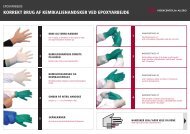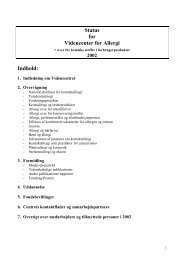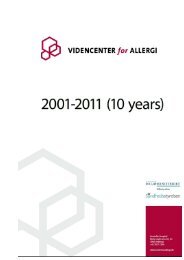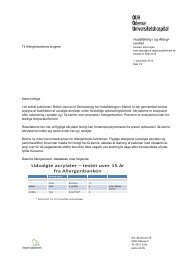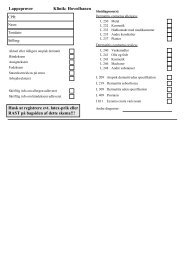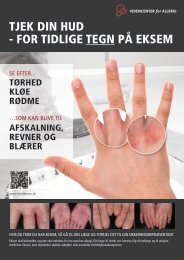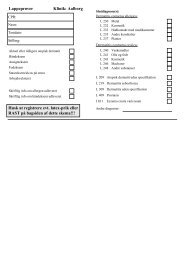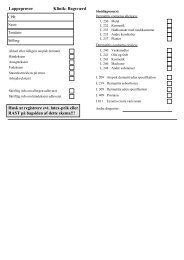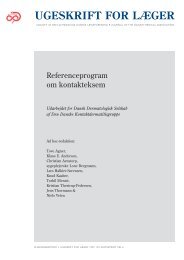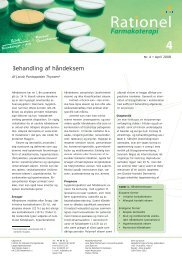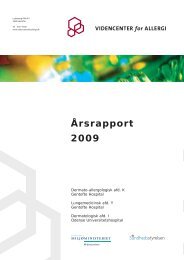Charlotte Devantier Jensen.pmd - Videncenter for Allergi
Charlotte Devantier Jensen.pmd - Videncenter for Allergi
Charlotte Devantier Jensen.pmd - Videncenter for Allergi
You also want an ePaper? Increase the reach of your titles
YUMPU automatically turns print PDFs into web optimized ePapers that Google loves.
cosmetic products with the exception of sunscreen products<br />
where the concentration must not exceed 0.025%. The reason<br />
<strong>for</strong> this different level in sunscreen products is that when the<br />
restriction of 0.1% was established, no skin penetration data<br />
was available <strong>for</strong> sunscreens and the use of MDBGN herein<br />
was there<strong>for</strong>e initially banned. In 1992, data from an in vitro<br />
penetration study was available and the use of MDBGN in<br />
sunscreens was re-considered and a concentration limit of<br />
0.025% was reached 39 .<br />
In previous predictive animal tests and HRIPTs, MDBGN<br />
appeared to be a weak sensitizer 39–41 and as it moreover was a<br />
very efficient cosmetic preservative, Euxyl K 400 became increasingly<br />
popular; in part as an alternative to the problematic<br />
Kathon CG. However, the first report of allergic contact dermatitis<br />
from Euxyl K 400 in a cosmetic product was published<br />
in 1989 42 , and since, numerous cases of allergic contact dermatitis<br />
has been reported from MDBGN in products such as<br />
soaps, moisturizers, cleansing milk, eye gel, ultrasonic gel,<br />
moistened toilet paper, sunscreen lotion, cleansing agent, and<br />
detergent (summarized in Table 1). The very first report of allergic<br />
contact dermatitis from MDBGN was published in 1983.<br />
Here a factory worker had developed eczema from using a paste<br />
glue <strong>for</strong>mulation containing the MDBGN-containing biocide,<br />
Tektamer 38 43 . <strong>Allergi</strong>c contact dermatitis caused by MDBGN<br />
as a cosmetic ingredient is often more severe than what is usually<br />
seen <strong>for</strong> cosmetic dermatitis, which may be an indication<br />
of use of a potent allergen in too high concentrations 44 .<br />
As the use of MDBGN became increasingly widespread,<br />
several dermatological clinics in Europe reported of a rising<br />
number of patients found patch test positive to the chemical<br />
(summarized in Table 2). In 2000, a 10-year analysis of the<br />
level of reactivity to common cosmetic preservatives in Europe<br />
was published by the European Environmental and Con-<br />
Contact allergy to the preservative methyldibromoglutaronitrile 9<br />
Fig. 3. The figure shows the average sensitivity rates of 7 cosmetic preservatives from 1991 to 2000 calculated by combining all the positive<br />
patch test results of 16 European clinics. The data <strong>for</strong> MDBGN is based on 48,485 individuals tested over the decade.<br />
tact Dermatitis Research Group (EECDRG) 31 . This analysis<br />
showed the average sensitivity rates to 7 cosmetic preservatives<br />
calculated by combining all the positive patch test results<br />
of consecutive patients with eczematous skin conditions<br />
from 16 dermatology clinics in 11 European countries (Fig.<br />
3). This included data <strong>for</strong> MDBGN based on 48,485 individuals<br />
tested over a decade. The report revealed a rise in the average<br />
frequency of sensitivity to MDBGN in eczema patients<br />
from 0.7% in 1991 to 3.5% in 2000 in the participating clinics.<br />
These observations promoted MDBGN to an important contact<br />
allergen in Europe and urged a safety re-evaluation of the<br />
use of the chemical.<br />
The current regulation of MDBGN is based on 11 predictive<br />
animal tests (GPMTs) and 7 HRIPTs 39 and all indicated that<br />
MDBGN was non-sensitizing. In light of the high number of<br />
cases of contact allergy to MDBGN reported, Hausen 41 in 1993<br />
published a sensitization study of MDBGN using a modified<br />
Freund’s complete adjuvant test which is considered as sensitive<br />
as the GPMT. He found MDBGN to be a distinct, but weak<br />
sensitizer with a low risk of sensitization and welcomed it as a<br />
replacement <strong>for</strong> Kathon CG. Further, a few years later<br />
Wahlquist et al 74 conducted sensitization studies of MDBGN<br />
using the GPMT, the Cumulative Contact Enhancement Test<br />
(CCET) (another guinea pig test method using Freund’s adjuvant)<br />
75 , and the LLNA. Again, the GPMT did not demonstrate<br />
any significant difference between the MDBGN-exposed and<br />
control animals, but the CCET and the LLNA both classified<br />
MDBGN as a sensitizer. It was speculated that the different<br />
results of the predictive tests may be due to the number of<br />
topical applications in the tests; maybe multiple applications<br />
of MDBGN is necessary <strong>for</strong> sensitization. The GPMT has only<br />
a single topical application, while the CCET and LLNA have<br />
multiple topical applications. It was, however, questioned why<br />
Forum <strong>for</strong> Nord Derm Ven Vol. 10, 2005 – Suppl. 8




